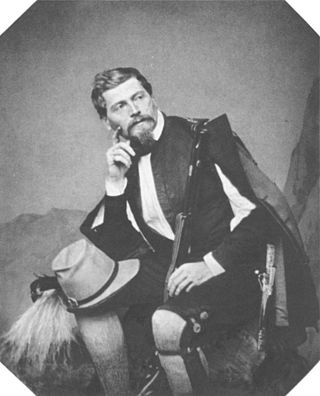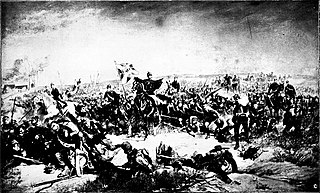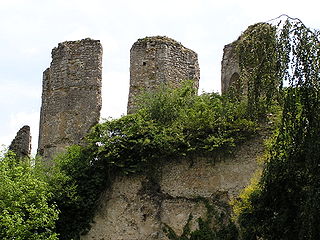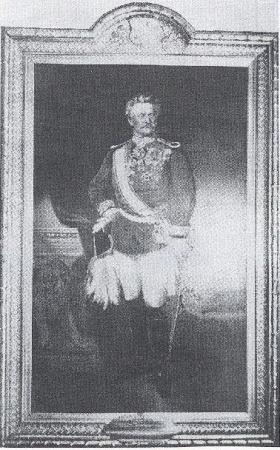
Antoine Eugène Alfred Chanzy was a French general, notable for his successes during the Franco-Prussian War and as a governor of Algeria.

Ludwig Samson Heinrich Arthur Freiherr von und zu der Tann-Rathsamhausen was a Bavarian general.

Francs-tireurs were irregular military formations deployed by France during the early stages of the Franco-Prussian War (1870–71). The term was revived and used by partisans to name two major French Resistance movements set up to fight against the Nazi Germans during World War II.

The Battle of Le Mans was a German victory during the Franco-Prussian War that ended French resistance in western France.

The Battle of Loigny–Lumeau-Poupry was a battle of the Franco-Prussian War. It took place on 2 December 1870 during the Loire Campaign on a frontline between Loigny, Lumeau and Poupry.

The Battle of Bazeilles was fought on 1 September 1870 during the Franco-Prussian War as a portion of the larger Battle of Sedan and was one of the first battles to feature modern urban warfare tactics. It took place in Bazeilles, France, a small village in the department of Ardennes near Sedan, and involved a force of Bavarian soldiers battling against French marines and partisans.
The Armée de la Loire was a French army of the Franco-Prussian War. It was formed in October 1870 by Léon Gambetta, interior minister and minister for war in the Government of National Defence, then taking refuge in Tours after the French defeat at Sedan on 2 September 1870 had destroyed the Imperial field army. The newly raised force was formed out of francs-tireurs, provincial Gardes Mobiles (territorials), naval forces, zouaves and tirailleurs from Algeria, plus regular soldiers in depots and reservists. Together these diverse units formed the 15th army corps under Joseph Édouard de la Motte Rouge. Apart from the North African units, the Army had few officers with fighting experience, insufficient artillery, and under-trained troops. It fought at the Battle of Orléans (1870) and Battle of Le Mans (1871) and was dissolved on 14 March 1871.
The Battle of Beaugency took place during the Franco-Prussian War between the army group of the Grand Duke of Mecklenburg, and the French Armée de la Loire, won by the Prussians. It lasted from 8 to 10 December 1870 and occurred on the left bank of the river Loire to the northwest of the town of Beaugency. Due to the large area over which it was fought, it is also known as the Battle of Beaugency-Cravant or the Battle of Villorceau-Josnes.

The Battle of Villepion took place between the French XVI Corps under General Chanzy and the I Bavarian Corps during the Franco-Prussian War. It occurred in the district of Terminiers, between Terminiers and Nonneville on 1 December 1870, and ended in a French victory.

Jakob Freiherr von Hartmann was a Bavarian general who served in the Austro-Prussian War and Franco-Prussian War.

The Battle of Châteaudun was a battle in northwestern France during the Franco-Prussian War, which took place on October 18, 1870. In this battle, the Imperial German Army led by General Friedrich Wilhelm Ludwig von Wittich attacked the city of Châteaudun and captured the city. During the nine-hour battle the attackers defeated forces that included Francs-tireurs led by Ernest de Lipowski who was of Polish origin. Although it ended in defeat, the resistance of the French army at Châteaudun is recorded by one document as legendary. The fighting at Châteaudun was immortalized by a painting by Philippoteaux.
The Battle of Dreux was a battle during the Franco-Prussian War, which took place on 17 November 1870. In this brief and drastic battle, the Prussian army who was commanded by Grand Duke Freidrich Franz II beat the French army who was commanded by Captain Keratry who ordered across the frontline and forcing the French to hurriedly flee, despite the numerical advantage of the French. The primary importance of the Prussian victory over Dreux in strengthening the frontline to its farthest and to weaken the French further to continue the Siege of Paris, and facilitate Minister Ludwig von der Tann of Bavaria who coordinated with Prince Friedrich Karl of Prussia to attack the French army under General Louis d'Aurelle de Paladines.
The Battle of Chateauneuf-en-Thimerais was a battle of the Franco-Prussian War, which took place on November 18, 1870, in the commune of Châteauneuf-en-Thymerais in France. This was one of a series of victories by a division of the Prussian army along the Loire under the command of Frederick Francis II, Grand Duke of Mecklenburg-Schwerin before the Garde Mobile's forces fledgling by commander Minister Fiereck, within a week after the Imperial German Army was defeated at the Battle of Coulmiers. During the Battle of Châteauneuf-en-Thimerais, the 22nd Division of the Kingdom of Prussia – noted as a brave division – was under the command of General Friedrich Wilhelm Ludwig von Wittich who captured the commune, taking in his hands hundreds of French prisoners of war. The failure at this battle forced the French forces to retreat westward.

The Battle of Artenay' also known as the Battle of Arthenay, took place during the Franco-Prussian War, on October 10, 1870, in Artenay a small town located on the road from Orléans to Paris, France which was about 10 miles north of the city of Orléans. In this fierce battle, with superior strength compared to the opponent, The I Corps of the Kingdom of Bavaria, under the command of Lieutenant General Ludwig von der Tann-Rathsamhausen, in collaboration with the 22nd Division of the XI Corps of the Kingdom of Prussia and the two cavalry divisions of the Prussian army attacked and penetrated the defense system of the army of the Loire of the young French Republic, under the control of general Joseph Edouard de la Motterouge, causing heavy losses for the French military of which many people were taken prisoner. The winning conditions Artenay were favorable enough for Von der Tann to strike Orléans, while the forces of France knocked back on Orléans forest in an agitated state. Despite this, Nièvre's Garde Mobiles and the Pontifical Legion in the French army were noted for their strong resistance, while a monk in Prussian Cavalry under the command of Prince Albrecht demonstrated his prowess in the battle at Artenay.
The Battle of Ladon and Mézières was a battle fought at Ladon and Mézières-en-Gâtinais between the French Army of the Loire led by Louis d'Aurelle de Paladines and Imperial German Army led by Prince Friedrich Karl of Prussia on November 17, 1870. During the battle the Prussians forced the French forces to retreat into the Bellegarde woods. Although the French army was quickly defeated in this battle, it showed the Prussians the substantial size of the French XX corps. the engagement showed the Germans that substantial forces of the French XX Corps were present on the battlefield. The defeat caused great damage to French morale. On November 17 the French attacked the Prussians again at the Battle of Beaune-la-Rolande, but they were defeated again.
The siege of Mézières was a siege battle during the Franco-Prussian War, it took place from November 17, 1870 until January 2, 1871, in Mézières-en-Gâtinais which is located on the banks right of the river Meuse in France. After suffering from a German artillery strike, the French army at Mézières under the command of Colonel Vernet, surrendered to Germany under the command of Major General Wilhelm von Woyna on January 2, 1871. Although lasting just over a day, German artillery bombardment caused French defenders and civilians in Mézières heavy losses. With the victory, the Germans captured many French officers and soldiers, with many cannons and supplies from the enemy's reserves. Not only that, the victory at the Siege of Mézières made the German army have complete dominance of the railway line in the north extending from Metz and Mézières to Paris, capital of France.
The Fighting in Fréteval was a battle in the Franco-Prussian War, it occurred in December 14 — 15, 1870, near the village of Fréteval of France. In this fierce engagement, a corps of the Prussian army under the command of Friedrich Franz II, Grand Duke of Mecklenburg-Schwerin contested Fréteval with a force of the French army 's Loire Corps under General Antoine Chanzy, but neither side was able to seize the advantage. The battle demonstrated the effective combat capabilities of Chanzy's forces, with a huge numerical superiority over Mecklenburg's forces. From 15 December, however, Mecklenburg's army was reinforced on the left, and in light of that situation Chanzy finally made a retreat to Le Mans.

The Battle of Vendôme took place during the Franco-Prussian War, it lasted from December 14–17, 1870 in Vendôme, Loir-et-Cher, France. In this fierce fighting, the X Army of the Kingdom of Prussia under the command of General Konstantin Bernhard von Voigts-Rhetz and the 2nd Army of Prussia which was commanded by Prince Friedrich Karl, attacked the French Army of the Loire by Minister Antoine Chanzy and Admiral Bernard Jaureguiberry who was a former navy officer of France. The Prussians defeated the French in a gun battle on December 16 and finally won the battle. With this victory, the Germans attacked the enemy's right flank and forced the French forces to withdraw from their stronger defensive position at Fréteval, where they engaged another Prussian army indecisively. The victory at Vendôme also brought the Prussian armies some French prisoners and weapons, while the disadvantage of Chanzy's army forced him to hastily withdraw to Le Mans.
The Fighting at Épuisay was a military conflict of the Franco-Prussian War, it took place on 17 December 1870, in Épuisay where there was a junction of roads from Vendôme and Morée to Saint-Calais. This was a battle between the rear forces of the Armée de la Loire of the French Republic under the command of Antoine Chanzy with the German army in retreat after X Legion being defeated in the Battle of Vendôme on 16 December 1870. Under the command of General Ludwig von der Tann-Rathsamhausen, the German army captured Epuisay and captured 230 prisoners.

Johann Baptist Ritter von Stephan, also known as Baptist von Stephan, was a Bavarian General of the Infantry who took part in the Austro-Prussian War and Franco-Prussian War and became a known Bavarian military figure during the 19th century for his efforts.












